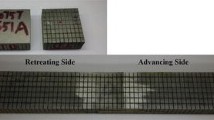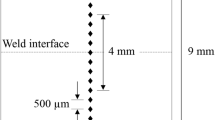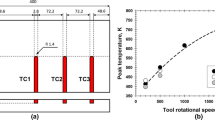Abstract
A friction-stir-welded (FSW) AA7050-T7451 pre-stretched plate was investigated nondestructively using the short-wavelength X-ray diffraction method to study the distribution of internal residual stress. During the investigation, anomalous deviation of the diffraction peak with crystal plane Al (111) was observed causing large testing errors. The relationship between texture of the material and the anomalous deviation peaks of (111), (200) and (311) and the method to eliminate their effect on residual stress determination were investigated. In addition, the comparison of the average d 0 method and the in situ d 0 method was performed using the three crystal planes to solve the problem caused by gradient in weld structure. Results showed that the anomalous deviations of different crystal planes were different from each other in the directions deflected from the maximum pole density direction. The method of residual stress determination performed in the directions of maximum pole density proved to be helpful to reduce the effect of anomalous deviations. The values and profiles of the residual stress tested by this method using (111), (200) and (311) were identical. The results suggest that in situ d 0 method could be used to eliminate the influence of the difference in lattice spacing among different areas of the FSW plate. The errors of residual stress determination decreased with the increase in the diffracting plane crystal indices.










Similar content being viewed by others
References
Withers PJ, Bhadeshia H (2001) Overview—residual stress part 2—nature and origins. Mater Sci Tech Lond 17(4):366–375
Huang X, Liu Z, Xie H (2013) Recent progress in residual stress measurement techniques. Acta Mech Solida Sin 26(6):570–583
Zhang XX, Ni DR, Xiao BL, Andrä H, Gan WM, Hofmann M, Ma ZY (2015) Determination of macroscopic and microscopic residual stresses in friction stir welded metal matrix composites via neutron diffraction. Acta Mater 87:161–173
Salih OS, Ou H, Sun W, McCartney DG (2015) A review of friction stir welding of aluminium matrix composites. Mater Des 86:61–71
Jamshidi Aval H (2015) Microstructure and residual stress distributions in friction stir welding of dissimilar aluminium alloys. Mater Des 87:405–413. doi:10.1016/j.matdes.2015.08.050
Rodriguez RI, Jordon JB, Allison PG, Rushing T, Garcia L (2015) Microstructure and mechanical properties of dissimilar friction stir welding of 6061-to-7050 aluminum alloys. Mater Des 83:60–65. doi:10.1016/j.matdes.2015.05.074
Woo W, An GB, Em VT, De Wald AT, Hill MR (2015) Through-thickness distributions of residual stresses in an 80 mm thick weld using neutron diffraction and contour method. J Mater Sci 50(2):784–793. doi:10.1007/s10853-014-8638-9
Ahi AM, Yousefi J, Najafabadi MA, Esmaeilzare A, Oskouei AR (2017) Residual stress evaluation in friction stir-welded aluminum plates using finite element method and acoustic emission. J Mater Sci 52(4):2103–2116. doi:10.1007/s10853-016-0498-z
Treml R, Kozic D, Zechner J, Maeder X, Sartory B, Gänser HP, Schöngrundner R, Michler J, Brunner R, Kiener D (2016) High resolution determination of local residual stress gradients in single- and multilayer thin film systems. Acta Mater 103:616–623. doi:10.1016/j.actamat.2015.10.044
Kurz SJB, Meka SR, Schell N, Ecker W, Keckes J, Mittemeijer EJ (2015) Residual stress and microstructure depth gradients in nitrided iron-based alloys revealed by dynamical cross-sectional transmission X-ray microdiffraction. Acta Mater 87:100–110. doi:10.1016/j.actamat.2014.12.048
Zhu LN, Xu BS, Wang HD, Wang CB (2012) Microstructure and nanoindentation measurement of residual stress in Fe-based coating by laser cladding. J Mater Sci 47(5):2122–2126. doi:10.1007/s10853-011-6012-8
Biro AL, Chenelle BF, Lados DA (2012) Processing, microstructure, and residual stress effects on strength and fatigue crack growth properties in friction stir welding: a review. Metall Mater Trans B 43(6):1622–1637. doi:10.1007/s11663-012-9716-5
Biallas G (2013) Effect of welding residual stresses on fatigue crack growth thresholds. Int J Fatigue 50:10–17. doi:10.1016/j.ijfatigue.2012.07.002
Prime MB, Hill MR (2002) Residual stress, stress relief, and inhomogeneity in aluminum plate. Scr Mater 46(1):77–82
Cavaliere P, Cerri E, Squillace A (2005) Mechanical response of 2024–7075 aluminium alloys joined by Friction Stir Welding. J Mater Sci 40(14):3669–3676. doi:10.1007/s10853-005-0474-5
Ramirez-Rico J, Lee SY, Ling JJ, Noyan IC (2016) Stress measurement using area detectors: a theoretical and experimental comparison of different methods in ferritic steel using a portable X-ray apparatus. J Mater Sci 51(11):5343–5355. doi:10.1007/s10853-016-9837-3
Zheng L, He C, Peng Z (2009) Measuring device for the shortwavelength x ray diffraction and a method thereof. US Patent 7583788. Patent
Zhang J, Li F, Zheng L, Guo X (2013) Internal residual stresses in the friction stir weldment of 2024-T351 Al alloy determined by short wavelength X-ray diffraction. Chin J Mech Eng 49(2):77–88
Zhang J, Zheng L, Guo X, Ji V, Klosek V (2014) Residual stresses comparison determined by short-wavelength X-ray diffraction and neutron diffraction for 7075 aluminum alloy. J Nondestruct Eval 33(1):82–92. doi:10.1007/s10921-013-0205-9
Kortright JB, Thompson AC (2009) X-ray energy emission energies. In: Thompson AC (ed) X-ray data booklet. Lawrence Berkeley National Laboratory, Berkeley
Bunge HJ, Wenk HR, Pannetier J (1982) Neutron diffraction texture analysis using a 2θ-position sensitive detector. Texture Microst 5(3):153–170. doi:10.1155/TSM.5.153
Woo W, An GB, Truman CE, Jiang W, Hill MR (2016) Two-dimensional mapping of residual stresses in a thick dissimilar weld using contour method, deep hole drilling, and neutron diffraction. J Mater Sci 51(23):10620–10631. doi:10.1007/s10853-016-0283-z
Masubuchi K (2013) Analysis of welded structures: residual stresses, distortion, and their consequences. Elsevier, Amsterdam
Hutchings MT, Withers PJ, Holden TM, Lorentzen T (2005) Introduction to the characterization of residual stress by neutron diffraction. CRC Press, Boca Raton
Mou J (2010) Characterization research of aluminium alloy internal defect by short wavelength X-ray diffraction. University of Science and Technology Beijing, Beijing
Gao Z (2010) Measuring the residual stress through thichkness of aluminum alloys by short wavelength X-ray. University of Science and Technology Beijing, Beijing
Robinson JS, Tanner DA, Truman CE, Paradowska AM, Wimpory RC (2012) The influence of quench sensitivity on residual stresses in the aluminium alloys 7010 and 7075. Mater Charact 65:73–85. doi:10.1016/j.matchar.2012.01.005
Robinson JS, Hossain S, Truman CE, Paradowska AM, Hughes DJ, Wimpory RC, Fox ME (2010) Residual stress in 7449 aluminium alloy forgings. Mater Sci Eng A 527(10–11):2603–2612. doi:10.1016/j.msea.2009.12.022
Zhang Z, Wu Q, Grujicic M, Wan ZY (2016) Monte Carlo simulation of grain growth and welding zones in friction stir welding of AA6082-T6. J Mater Sci 51(4):1882–1895. doi:10.1007/s10853-015-9495-x
Field DP, Nelson TW, Hovanski Y, Jata KV (2001) Heterogeneity of crystallographic texture in friction stir welds of aluminum. Metall Mater Trans A 32(11):2869–2877. doi:10.1007/s11661-001-1037-2
Barlat F, Richmond O (1987) Prediction of tricomponent plane stress yield surfaces and associated flow and failure behavior of strongly textured f.c.c. polycrystalline sheets. Mater Sci Eng 95:15–29. doi:10.1016/0025-5416(87)90494-0
Wang X, Hu HE, Xia J (2009) Effect of deformation condition on plastic anisotropy of as-rolled 7050 aluminum alloy plate. Mater Sci Eng A 515(1–2):1–9. doi:10.1016/j.msea.2009.03.061
Ji P, Yang Z, Zhang J, Zheng L, Ji V, Klosek V (2015) Residual stress distribution and microstructure in the friction stir weld of 7075 aluminum alloy. J Mater Sci 50(22):7262–7270. doi:10.1007/s10853-015-9280-x
British Standards Institute (2008) Non-destructive testing–test method for residual stress analysis by X-ray diffraction. BS EN 15305:2008.European Committee for Standardization, London
Non-destructive testing. Standard test method for determining of residual stresses by neutron (2008) Non-destructive testing. Standard test method for determining of residual stresses by neutron. ISO/TS 21432:2008.International Organization for Standardization, Geneva
Ferreira-Barragáns S, Fernández R, Fernández-Castrillo P, González-Doncel G (2012) Kinetics of tri-axial and spatial residual stress relaxation: study by synchrotron radiation diffraction in a 2014Al alloy. J Alloys Compd 523:94–101. doi:10.1016/j.jallcom.2012.01.081
Withers PJ, Preuss M, Steuwer A, Pang J (2007) Methods for obtaining the strain-free lattice parameter when using diffraction to determine residual stress. J Appl Crystallogr 40(5):891–904
Welzel U, Ligot J, Lamparter P, Vermeulen AC, Mittemeijer EJ (2005) Stress analysis of polycrystalline thin films and surface regions by X-ray diffraction. J Appl Crystallogr 38(1):1–29. doi:10.1107/S0021889804029516
Acknowledgements
This work is supported by the National Natural Science Foundation of China (Grant No. 51275037), the National Key R&D Plan (Grant No. 2016YFB0301105) and the Fundamental Research Funds for the Central Universities (Grant No. FRF-TP-16-016A1).
Author information
Authors and Affiliations
Corresponding author
Ethics declarations
Conflict of interest
The authors declare that there are no potential conflicts of interest with respect to the research, authorship and/or publication of this article.
Rights and permissions
About this article
Cite this article
Ji, P., Zhang, J., Zheng, L. et al. Comparison of residual stress determination using different crystal planes by short-wavelength X-ray diffraction in a friction-stir-welded aluminum alloy plate. J Mater Sci 52, 12834–12847 (2017). https://doi.org/10.1007/s10853-017-1321-1
Received:
Accepted:
Published:
Issue Date:
DOI: https://doi.org/10.1007/s10853-017-1321-1




